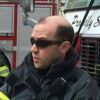As the saying goes, “Teamwork makes the dream work.” While firefighters are used to working in teams on the emergency scene, teamwork in the front seat of the apparatus is often overlooked. And that can have dire consequences.
There’s a lot of magic that happens in the front of the cab. Response routes are chosen. Critical pre-arrival decisions are made. And the overall safety and wellbeing of the apparatus, its occupants and the public we encounter between the firehouse and the scene are firmly in the hands of the two people sitting in the front. In the event of an apparatus mishap, neither the driver nor the officer has the luxury of giving the classic, noncommittal answer, “I was in a seated position, with my seatbelt fastened, facing the rear of the apparatus when the alleged incident took place.”
Occupying the front seats of the rig comes with a lot of responsibility. That’s why those positions are often achieved through promotions in the career fire service and elections on the volunteer side.
Upon Arrival
The first five minutes of nearly every fire-related operation will often dictate what happens for the next five hours. Those critical first few minutes are frequently determined by the decisions and actions of the personnel occupying the front seats of the apparatus. This is where the officer/driver dynamic comes into play. An officer and driver who have formed a solid teamwork relationship can be worth their weight in gold.
Does the officer want to see three sides of the scene while pulling up, if at all possible? Does the officer want to hit a hydrant on the way in? Are attack lines set up with different lengths and different nozzles? The driver needs to know when the answer to any of these questions is “yes”—and preferably in advance. The only way for that to happen is by building a team relationship.
Observing a first-arriving engine on the scene can reveal a lot about the team relationship between the driver and the officer. As the officer is performing the 360-degree size-up of the scene, is the driver pulling a cross-lay with a smooth bore or a combination nozzle to the front door? Does the driver automatically pull a 2½” line for exposure protection? Or does the driver get out of the rig, put down a chock block, and wait until the officer returns from the sojourn around the scene to do anything else? A driver who has a well-established team relationship with the officer will know exactly what the officer wants and will set things in motion without needing express orders.
Note: There is a difference between anticipating the officer’s needs and freelancing. Consider the common practice of establishing standing orders in EMS. These orders take the guesswork out of treatment options for the medics. Establishing a solid team environment between the officer and the driver of the fire apparatus can accomplish the same goal.
The Officer’s Role
But it’s not all about the officer. The driver may need the officer to look up a street or spot a hydrant. If there is information about the scene coming across the computer, such as hazardous materials, trapped civilians or even the order in which the apparatus is due to arrive, the driver needs to know so appropriate apparatus placement decisions can be made. If one of the other assigned units is replaced en route or responding from somewhere other than the station, the driver needs to know so they can anticipate intersections where the apparatus may cross paths.
A tight-lipped officer can cause poor apparatus placement at best and can cost lives at worst. Imagine the driver anticipating the apparatus will be the third unit to arrive and knowing the second-due engine has the water supply assignment. But the normally second-due unit is out-of-service and not responding. If the officer doesn’t relay the information to let the driver know they’ll be second-due, the driver may miss the hydrant on the way in, thus delaying a positive water supply. But an officer who recognizes the team atmosphere in the front of the cab will make sure the driver knows they will be second-due and will probably help spot the closest hydrant to achieve the mission.
The driver and officer are also responsible for the safe operation of the apparatus. That means two sets of eyes to look out for issues at intersections, judge clearances and ensure the rest of the crew is seat-belted at all times. My first officer had a set of hand signals he used when the apparatus approached an intersection visible to him but blind to the driver. It was a fist to “stop” and a wave of the index finger to “go.” His theory: Words could be mistaken, but signals could not.
That was all fine when the promoted driver/engineer was driving. It was even OK when one of the senior firefighters was acting as the apparatus operator. They all understood how the officer wanted the team to work in those situations. But when the rookie (me) was learning to drive the engine, nobody told me about this system. That is, nobody told me until I pulled up to an intersection that was blind to my right side and the officer gave the waving index finger when I asked him how it looked his way. This was before the days of headsets, so I just thought he didn’t hear me. So, I asked again. Then again. As I started to creep forward to catch a glimpse of his side of the intersection, he looked at me and told me to stop. That’s when he explained his hand signal system. He and I hadn’t built that teamwork relationship yet, and it showed.
Beyond the Apparatus
The benefits of a solid team relationship between the officer and the driver extend beyond the apparatus, too. In many cases, the driver is the liaison between the officer and crew within the firehouse. It’s the driver who will probably be the first to hear grumblings from the other crew members. When there is a team relationship between the driver and the officer, the driver is much more likely to head off small issues before they get to the officer and make the officer aware of problems before they grow. A well-paired team in the front seats of the apparatus will usually help produce a much more cohesive crew within the firehouse and on the emergency scene.
If the officer and driver don’t operate as a team, the firehouse will still function, and the apparatus will still go up and down the road. But operations will be much more efficient, effective and safer for the entire crew – and the community they serve – if the people occupying those prized front seats have cultivated a culture of teamwork.














